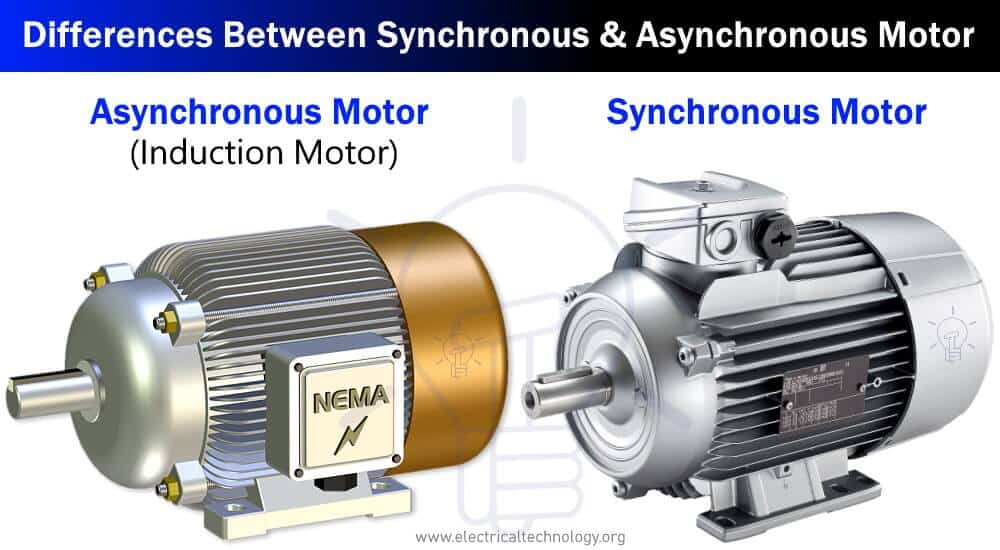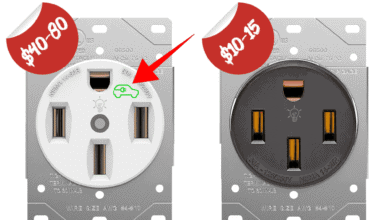Difference between Synchronous and Asynchronous Motor
What is the Difference between Synchronous and Asynchronous Motor (Induction Motor)
The electrical motors are machines that convert electrical energy into mechanical energy for performing mechanical operations. These motors can be designed to operate on alternating current (AC) or direct current (DC). The AC motors are classified into two types; Synchronous Motors and Asynchronous Motors. Both of them share some similarities such as in their construction but they are quite different in operation and their performance.
Before going into the list of differences between Synchronous motor and Asynchronous motor, we are going to discuss their basics and how they operate. For clear explanation, you may know the Difference Between Single Phase and Three Phase Power Supply related to the operations of single phase and three phase AC motors.
How do AC Motor Works?
As we know from our previous article ”differences between AC and DC motor”, the DC motors operates on the principle of magnetic field acting on a current carrying conductor that experiences a mechanical force. Where the stator generates a static magnetic field, and the rotor consisting of multiple winding carries the input DC current.
In AC motors, the idea of rotational magnetic field RMF is utilized. The stator is made of multiple windings that generate a varying magnetic field upon supplying the input alternating current. This magnetic field rotates around the rotor.
The rotor made from windings or closed loop conductors carry current either through induction or external current supply generates its own magnetic field. The magnetic field generated by the rotor interacts with the spinning magnetic field and starts rotating in its direction.
The relative difference between the stator rotational field and the speed of the rotor is called the slip. if the slip of the motor is zero or the rotor has the same rotational speed as the stator rotating field, the motor is called AC Synchronous motor. if an AC motor has a slip or there is a difference between the stator field speed and the rotor, the motor is called asynchronous motor. To know more about the different types of motors, refer to the previous posts about BLDC (Brushless DC) motor, stepper motors and servo motors.
Related Posts:
Synchronous Motor
As the name suggest, the synchronous motor has a rotor that is designed to rotate at the same speed as its stator rotating magnetic field called synchronous speed.
The stator generates a rotational magnetic field upon supply alternating current. The rotor can be designed to generate its own magnetic field using an external DC supply through slip rings or using a permanent magnet.
The rotor is designed to generate magnetic poles that are equal or integral multiple of the stator poles. When the stator and rotor is energized, the rotor magnetic field gets locked with the stator rotational magnetic field, and it rotates at the exact speed of stator field.
Due to inertia, the synchronous motor does not immediately starts at the synchronous speed (rotational magnetic field). Therefore, an additional winding called “damper winding” is used to provide starting torque. It acts as an induction motor during the startup. So, it suggests, the synchronous motors are not self-start, they need extra starting mechanism.
It can be either separately excited or non-excited motor i.e. the former requires a separate DC source energizes the rotor windings and generates a magnetic field while the latter describes a synchronous motor whose rotor is designed to be magnetized by the rotational stator magnetic field and rotates with it.
The synchronous motor’s rotor rotates with synchronous speed that depends on the supply frequency and the poles of stator windings. Therefore, the motor speed does not vary with the load. In order to vary the speed of a synchronous motor, the supply frequency must be varied. It is accomplished by using VFD (variable frequency drive).
Related Posts:
- Single-Phase Induction Motor – Construction, Working, Types & Applications
- Three-Phase Induction Motor – Construction, Working, Types & Applications
Asynchronous Motor
The asynchronous motor name suggests that the rotor speed is asynchronous with the rotational speed of the stator magnetic field. To be exact, the rotor of asynchronous motor rotates with a relatively lesser speed than the stator RMF. It is due to the presence of slip between its stator and rotor speed.
The rotor of the asynchronous motor is either a squirrel cage of wound type rotor. The squirrel cage rotor is constructed using heavy copper bars connected at the end using a conductive ring that electrically short them together. The wound type rotor is made of multiple windings on top of a steel laminated core.
The stator rotational magnetic field causes an induced current in the rotor. This induced current flows inside the rotor generating its own magnetic field. According to lenz’s law, this rotor field opposes the cause that’s generating it and tries to eliminate it by catching up to the speed of the stator RMF (the synchronous speed). In doing so, the rotor rotates in the direction of the stator RMF. Since it operates on the principle induction, therefore, asynchronous motor is also known as Induction motor.
The induction motor can never run on the synchronous speed instead it is always slower than the synchronous speed and it depends on the slip of the motor. The reason is because the induced current in the rotor is generated due to the difference between the stator and rotor field. if, in case it runs at the synchronous speed, it means the rotor is magnetically locked and there is not different between stator and rotor field. Therefore, there would be no magnetic flux to induce current in the rotor. The magnetic flux is necessary for induction motor which is why it has to run at slower speed than its synchronous speed.
The squirrel cage rotor has a simpler design and allows induced current to flow through the copper bars. While the wound rotor allows the user to vary the rotor current during it startup as used in “Motor starter”. The point is to safely start the motor by reduce the huge starting current drawn by an induction motor. It is generally done by connecting a variable resistor in series with the rotor windings through the means of slip rings.
The asynchronous motor speed depends on the slip of the motor that varies with the load and the rotor resistance. In other words, the induction motor speed can vary with the load or by using varying rotor resistance.
Related Post:
Differences between Synchronous Motor and Asynchronous Motor
The following table shows the key differences between synchronous motor and asynchronous (Induction) motor.
| Synchronous Motor | Asynchronous Motor |
| The synchronous motor is a type of AC motor that runs at synchronous speed. | The asynchronous motor is a type of AC motor that runs on speed less than the synchronous speed. |
| It operates on the principle of magnetic interlocking between rotor and stator field. | It operates on the principle of electromagnetic induction between stator and rotor. |
| There is no slip i.e. the slip of synchronous motor is equal to 0. | There is slip in induction motor and it is always greater than 0. |
| The speed of the motor depends on the supply frequency and the number of stator poles.
Ns = 120f / P |
The speed of the motor depends on the load, rotor resistance and the slip, s. it is always less than synchronous speed. N = Ns (1-s) N < Ns |
| The speed does not vary with varying the load connected to the motor. | The speed varies with varying the motor load. |
| It is not self-start and require extra windings for starting the motor. | Asynchronous motors are self-start and do not require extra mechanism. |
| The rotor requires an extra current supply. | The rotor of induction motor does not need extra supply. |
| Separately excited synchronous motor requires extra DC source to energize its rotor winding. | It does not require any extra source. |
| It also need slip rings and brushes to supply DC to its rotor windings. | It does not require slip rings, however, wound type can use slip rings to control the speed. |
| The motor speed is only controlled by varying the supply frequency through VFD. | The motor speed can be controlled using variable rotor resistance as well as VFD devices. |
| The input voltage supply does not vary the speed or torque of synchronous motor. | The input voltage supply can be used to vary the torque and speed of the motor. |
| The fluctuations in the main supply voltage do not affect synchronous motor operation. | The mains voltage fluctuation affects its speed and operation. |
| The initial cost is greater than Induction motor. | The induction motors are cheaper. |
| It is operation is complicated. | It is operation is simple and user friendly. |
| If offer great efficiency and precision. | They are not as efficient as synchronous motor. |
| It can be easily operated at very low speed using VFD. | It is quite difficult to operate at low speed. |
| It operates best at lower speed usually below 300 rpm. | It is best suited for operation at speed above 600 rpm. |
| It can be operated in lagging, leading or unity power factor by adjusting its excitation. | The induction or asynchronous motor always runs at lagging power factor. |
| It can also be used for power factor correction at the same time by utilizing it in leading power factor. | It cannot be used to correct power factor but only to drive mechanical loads. |
| Since it runs on constant speed, sudden variation in load will cause fluctuation in the drawn current. | There is no such phenomenon in induction motor. |
The conclusion of this article is that the synchronous motors are efficient but costlier and are used for ultra low rpm application while offering power factor correction feature. On the other hand, the induction motors are used for high rpm application with variable speed while being inexpensive and easier to operate.
Related post about Electrical Motors.
- DC Machine – Construction, Working, Types and Applications
- Speed Control of DC Motor – Voltage, Rheostatic & Flux Control Methods
- Cable Size Calculation for LT & HT Motors.
- What is Motor Starter? Types of Motor Starters and Motor Starting Methods
- Direct Online Starter – DOL Starter Wiring Diagram for Motors
- Difference between AC Drives and DC Drives







